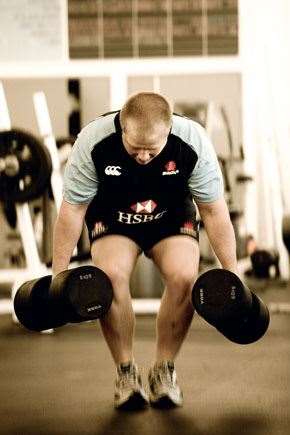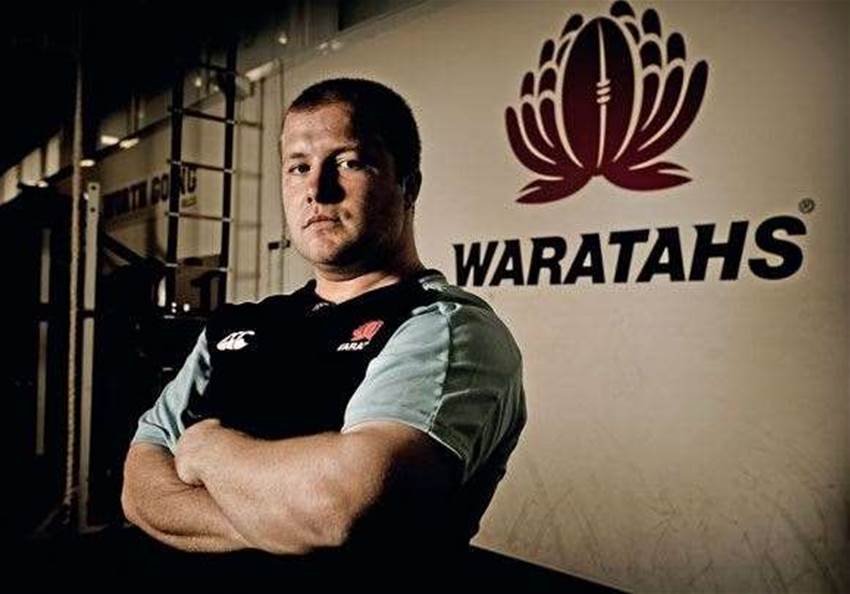The days of Australian scrummaging impotency are over.
The days of Australian scrummaging impotency are over.
 "As a front runner, you cant dread going to the gym ." Images: Wayne Fogde
"As a front runner, you cant dread going to the gym ." Images: Wayne FogdeForget the nightmare of Twickenham ’05 when Baxter was red-carded and Dunning was carried off on a stretcher and the Wallabies were forced into the indignity of uncontested scrums. And forget the shame of Stade Velodrome ’07, where the Wallabies’ pack again crumbled and the Poms sent us packing in the World Cup quarters. If there was one positive to emerge from last year’s Spring Tour it was this: the Wallabies’ scrum is back. They dominated the English, bashed the Irish and fractured the Welsh. At Millennium Stadium a 56th-minute scrum that saw the Welsh pack crumble like stale cake brought back memories of ’84 and that pushover try …At the centre of this renaissance is the Waratahs’ loose-head prop Benn Robinson. At 113kg he’s a relative fly-weight and with just 31 Test caps he’s a relative greenhorn, but Robinson’s scrummaging prowess is world-class. Here’s how he builds a body that can tame the seismic force of 16 men pushing head-to-head
Love the iron
“As a frontrower you can’t dread going to the gym because it’s a big part of what you do on the field. At the moment we’re probably doing four upper body and four leg sessions a week. If I have a week or two out of the gym, my body’s craving some weights work; I’m really looking forward to lifting again, getting those endorphins pumping, getting that buzz. It’s the same with scrummaging – you pack a good scrum, then you’re pumped up, excited about packing the next one. There’s a very close relationship there.”
Tree trunks
“We do a huge number of squats. We start with the basic squat and from there move into a lot of variational squats. There’s the bench or box squat: this involves sitting back onto a box where your hips are lower than your knees, then driving back up. This squat is very specific for forwards because it unloads the weight at a lower height, so when you push out of the squat, your legs are in a prime pushing position. This is the position you want your legs in when you’re scrummaging. You get power at different angles through your legs, and that power down low is the power you want in the scrum. “Then there’s the sumo squat, which is like a deadlift, but with an alternate grip – one hand facing out, the other facing in. This mainly hits your gluts and ensures you maintain a good pushing posture throughout the movement. “Then there’s the quarter squat, where you only drop a quarter of the way down. This is good because you can really load up the bar – 250kg plus – and work your top-end strength. “The reps and sets vary all the time. In the pre-season you want to get through as many reps as possible – eight-to-ten per set. In-season you want to look after your legs and back as much as possible, while also maintaining the strength and size you built in the pre-season. This means keeping the weight high while dropping the reps to four-to-six per set.”
 We’d be packing a hundred scrums a week. Images: Warren Clarke
We’d be packing a hundred scrums a week. Images: Warren ClarkeMoving up
“Our upper body weights vary from pre-season to in-season, but throughout the year we do a lot of bench press and a lot of bent-over rows. Most of it comes back to posture, making sure your back’s not arching, ensuring you’re keeping that inverted curve. This transfers directly into your scrummaging shape. So the bent-over row works your grip and lat strength – essential for your bind – but maintaining that good scrummaging posture throughout the exercise also switches on your stomach muscles, working your core strength. Again, the reps tend to be higher in the pre-season and then drop down in-season. You’re bound to lose a little bit of size and strength throughout the season, but ideally your in-season training will maintain what you built in the off-season.“The farmer’s walk is another fun little exercise. You basically load-up two dumbbells with as much weight as you can hold and then walk laps of the gym. This works your grip, your traps and your neck muscles. It’s a really tough exercise because it hits both your aerobic and anaerobic systems – the sweat’s pouring out of you by the end of each lap. We normally walk eight laps of the gym, up and down, with 65kg on each arm. Good fun!”
Bull neck
“A strong neck is crucial for a frontrower. We do a lot of neck work on the Swiss ball. In the most basic drill you place the ball against a wall, then adopt a scrummaging position, resting the crown of your head on the ball. Most of your body weight runs into your neck, working the neck muscles. You can increase the intensity of this exercise by holding weights below you; the more weight, the more pressure going through your neck. “Another exercise is to lie on your back, then form a plank on a Swiss ball, resting the back of your head on the ball. Again, your neck takes the strain and it really works the muscles along the back of your neck. We generally hold these exercises for around a minute.“In a scrum your neck can get in funny positions, so flexibility is a big part of neck conditioning. With all these exercises you have to make sure you work your neck through all the ranges it might reach out on the field – you can’t just work your neck in a neutral position because it’ll go beyond that in a game. So, while we’re doing this Swiss ball work, we’ll often roll our necks around, working movement into the exercise.”
 Ball Work Images:Warren Clarke
Ball Work Images:Warren ClarkeBall work
“For a frontrower, holding the perfect body shape is the key. In the scrum the ideal angle of leg drive (measured at the back of the knee) is between 100 and 120 degrees. So we try and replicate that in the gym by packing in this position against a Swiss ball. Once you’ve established that perfect posture, you can add variety. You can have two players packing on either side of the Swiss ball, giving it that “live” element. Or you can adopt the scrummaging posture with your elbows resting on the ball, extending your arms, putting more pressure on the shoulders and core. Basically, the key with all these exercises is maintaining the perfect pushing posture under fatigue; this is a massive issue when you’re scrummaging.”
Pack ’em
“In a typical scrummaging session we’d begin with a one-on-one drill, where you pack against another prop, focussing on holding a perfect shape. That then builds up to a two-on-one, say a hooker and loose-head packing on a tight-head. Again, the focus is holding the shape under increasing pressure. Then you move to drills, where, for example, one side falls back on engagement, forcing the other side to drive forward and catch up. After these small drills we move to larger scrums, five-on-five, then six-on-six. The focus here is on staying in sync, gelling with the bodies around you. “From there we move to the machine. Personally I gain a lot more from packing against a live opponent, but the machine is great for basics – making sure you’re in sync with the rest of your forward pack, ensuring you have good knee sync before engagement, your back and neck are in a neutral position, you’re engaging at the right height, not shooting toward the ground or driving up. We normally have three cameras on the scrum and after the session we’ll go and analyse all the frontrowers. There’s also a load meter on the scrum that records the impact at collision, the power that’s going through the scrum, etc.“We’d be packing a hundred scrums a week. With the live work we’d probably be doing 20 engagements a week, then there’s the small group stuff and the machine work. But scrummaging is such a high-impact activity, we can’t punch out too many scrums. In a match we average 15 to 16 scrums in 80 minutes and that really takes it out of your body; you need a lot of recovery time after that. In the past we used to do hundreds and hundreds of back-to-back scrums, but thankfully the work we now do on the training paddock is very specific for the numbers we’re likely to rack-up in a game.”
 The “fun” of the farmer’s walk. Images: Warren Clarke
The “fun” of the farmer’s walk. Images: Warren ClarkeRecovery
“We’re fortunate enough to have hot and cold baths next to our changeroom, so we normally jump in those for six minutes after each session. There’s a big lactic build-up after most of these sessions, so you want to get in the baths as soon as possible and flush that lactic out. You’ve also got to be very flexible as a frontrower, so we’re all involved in yoga programs over the pre-season. We also do plenty of stretching around our gluts and hip flexor muscles because your hips cop a real hammering in scrums.“As a frontrower you also want to be getting plenty of food in – maintaining your weight is very important. People would be surprised by how much a footballer eats. You’re on the field for a long time and you’re burning a lot of energy, so you have to eat a lot of meat, chicken, carbohydrates, protein shakes to maintain your weight and energy. I suppose our calorie intake would be roughly double the average person’s.”
Homework
“On the Monday after a game the frontrowers normally gather and look at the footage from the weekend. It’s all cut up so we can jump straight on the computers and examine the scrums. Most scrums can be viewed from three or four camera angles, to get a complete idea of the shape and movement of the scrum. Once we’ve reviewed that footage, discussed it in a meeting, we then wipe the slate and begin examining our opponents for the upcoming weekend. “The main focus leading into a game is our ball, making sure we get nice clean ball on our feed. When the opposition see they have no opportunities for attacking your ball, it can really sap their confidence. After that we look at opportunities where we can attack the other scrum. For example, we might target a certain scrum as having a weaker tight-head, so we’ll be looking to drive through him. Or we might see the entire scrum as being a little loose – the binds, the grips, the general body shapes – so we’ll look at going right through the middle of them. To an untrained eye all scrums look fairly similar, but a change of set-up or a change of a grip position can really alter the way a scrum goes forward. We have a lot of different options for the way we can set the scrum.”
Maintain the rage
“You have to have a mix of skill and strength as a frontrower – but you also have to enjoy scrummaging. It’s a high-impact area and if you go in a little bit soft, you can really get hurt. Even if your technique’s not quite right, if you bring that aggression it can save you.”
– Aaron Scott
Related Articles
.jpeg&h=172&w=306&c=1&s=1)
Glory dealt big ALW blow as Sydney sign Hana Lowry

Glory sign Stephen Peters as new women's coach













